Some people train for a competition, then once they’ve completed it once never toe that particular starting line again. I’m not like that. After competing at the Red Rock X-Challenge MTB/trail duathlon in 2016 (see my 2016 race report), I signed up for this year’s edition about one month in advance.
In theory, that should have given me a bit of time to fine-tune my mountain biking skills, which had become a bit rusty over the course of summer that I mostly spent road biking and running in the mountains. In reality, I only headed out on the course once (and just like last year, managed to get lost because I think the GPS track is a bit off towards the end). But either way, I think even that lone recon gave me a certain edge over people who came entirely unprepared.
Race morning
I arrived bright and early for the 9:30 race start. Getting into the Lycée Belval parking lot required a call to the attendant, but other than that everything was straightforward. I picked up my racing bib, dropped off my running shoes and water bottles (they would be shuttled to the transition zone), and then got ready. Since the race rules require you to wear your bib on the back for the mountain bike part, and on the front for the run, but I neglected to bring any kind of strap, I had to re-purpose a backup heart rate monitor strap for that task.
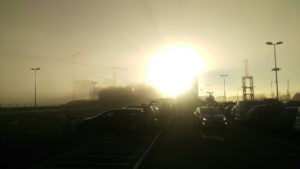
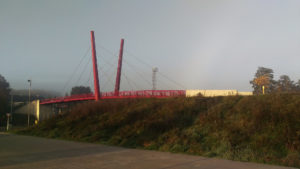
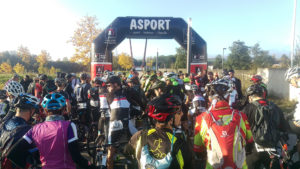
Leg 1 – 20.5km MTB ride
The previous year, I intentionally lined up towards the end of the pack at the start. This year I wanted to be smarter and better position myself; but didn’t take into account that while I was still warming up, most of the participants were already lining up. So just like last year, I was stuck behind slower riders and forced to start conservatively.
On the first climb of the day, just like last year, the biggest issue wasn’t the climb itself but rather the people in front of me who were moving too slow. Several looked like they were entirely unprepared for a mountain bike race to go uphill.
The next few kilometers, through the Gaalgebierg outside Belvaux were mostly on single trails that are quite technical. The rain of the previous days and the foggy morning made the surface quite damp, and exposed roots were quite slippery.
Bikers in the middle of the pack were still grouped together quite tightly, which led to a few interesting situations. There’s a few uphill spots where average riders dismount. I usually did so a few meters before most of the people around me, because I actually knew what was coming and that saved me the embarrassing moment where you’re stuck in the middle of a climb with too high of a gear, lose momentum and then have to emergency-unclip or risk falling over. But if you’re surrounded by other average riders, that means a few times you still get stuck behind emergency-unclippers; or someone thinks he can still go past you (before realizing that no, he has to unclip too).
Once or twice, my lack of advanced mountain biking technique caught up with me, too. I almost fell not once but twice, and each time I had to clip back in and let a few people get past me; and invariably would then stay stuck behind them because if I hadn’t messed up I would have been faster than them.
After surviving the first 5km, the next 5km through the woods towards Differdange were mostly unremarkable. I was able to push a little more.
11.5km in, we crossed a short mining tunnel. After the tunnel there’s a sharp turn and then an immediate climb. The sudden change from going 30km/h to turning and climbing can lead to issues if you don’t shift down in time. It had happened to me during a recon ride, and judging by the swearing I heard during the race it also happened to at least one rider shadowing me.
The next kilometers were mostly unremarkable. The bulk of the easy position changes were behind us and each subsequent gain had to be earned. The riding here was less technical, but in between a few unpredictable (but well-signed) turns and a few muddy patches you still had to pay attention.
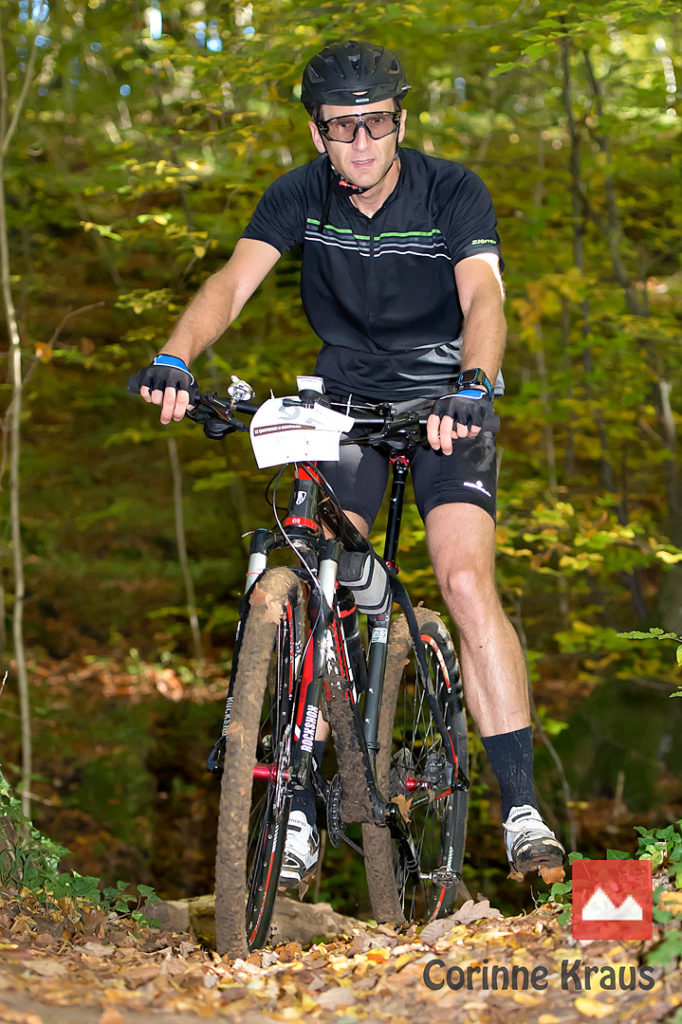
Just before the transition zone sits a fairly demanding downhill to Fonds de Gras. I chose to ride conservatively here, and what that meant was that I chose to not ride at all but rather to walk down the bike. Obviously, this was the spot where two race photographers were situated. I remarked to each one that I wasn’t giving them remarkable material to shoot, but of course I’d rather be prudent than hit the dirt. Needless to say, a few riders shot down past me at this point.
My first MTB leg took me 1:11:07 according to the official timing. This put me in 38th place out of the 92 people that finished with chip timing. Both the time and position was a little better than the previous year.
Leg 2 – 9.3km trail run
I was a bit more efficient during the transition than during last year’s first attempt. It still took me about two minutes to get rid of my cycling gear (helmet, glasses, gloves, shoes) and get into my Salomon Speedcross 4. I learned from last year’s edition (where I did not hydrate well enough) and had put a full bottle of water in my drop bag, which I took out on the trail run course.
Just like last year, I set off at around a 5:30min/km pace. Almost straight away, a few people zoomed past me. The course, which loops around Réserve naturelle Prenzebierg (also referred to as Gielebotter on the race website), isn’t overly spectacular. It starts off level, and while there’s a few climbs it’s never really steep, and never really technical either.
Ideally, I should have been able to run faster. But at this point my body was in self-conservation mode and I decided that whatever I was capable of doing at around 150bpm was better than if I pushed myself and then faded on the next MTB leg. On the first uphill of the course, my pace slowed down to a paltry 6:12min/km (km4). I stabilized the pace at a slightly faster speed after that, but even the 5:00min/km downhill towards the end couldn’t improve my overall pace of 5:40min/km.
My running time of 52:41 (according to official timing) is the 65th worse of all competitors. Which is funny, because apparently even though I consider myself more of a runner and less of a mountain biker, during this race I was stronger on the bike than on my feet.
Leg 3 – 18.6km MTB ride
The second transition took me a bit longer than the first. I distinctly remember fighting the drop bag for a bit, to get the re-purposed shopping bag to safely close and prevent my shoes for spilling out during the transport back to the finish line.
Since the weather was heating up considerably over the course of the morning, I was happy that another bottle had been waiting for me in my drop bag. This meant that I could change to a full bottle for my second bike leg, and didn’t need to rely on the race organizers for hydration (there was only one feed station on the course, which was situated at the transition zone and therefore could be accessed twice). But small 0.1 litre plastic cups of water are cumbersome if you don’t want to lose any time.
Straight out of the transition zone there was another climb. I went out at a decent effort, and before long passed another rider who seemed to be in a fairly low place. He pretty much stopped to the right side to let me go past.
Unlike last year where I was passing and getting passed by quite a few people along the way, this year I was alone for most of the MTB ride back to the finish line. The only people I encountered were a handful of riders who looked like they’d run out of energy.
This made the race slightly more challenging, because if there’s nobody fast in front you might still catch and nobody behind you that you want to keep behind, there’s less incentive to go as fast as possible. Of course it’s a race, and of course you want to do well, but if you’re not careful it’s easy to become complacent and lose your focus on riding at the best-possible speed every second of the way.
Because I was riding so much without any direct contact with other competitors, doubts started to creep in about whether I was still on the right track. I’d ridden most of the course before, and obviously I’d ridden it in its entirety last year, but towards the end of the race your thoughts tend to go a little foggy. But every time my lizard brain tried to get me to panic, I would see a “Red Rock Challenge” flag, or a blue line on the ground. I did hear later that some people did indeed get lost on the course, but from my point of view there were plenty of signs (although occasionally I only saw them at the last second when I wasn’t paying enough attention).
After about 11 kilometers of mostly easy riding where you can go quite fast, the next 5 kilometers will wreak havoc on your averages. The surface and route is not terribly technical, but there’s lots of small twists and turns; and overall fatigue is then adding another layer of sluggishness to everything you do.
Finally, I came to the parking lot where the single trail started almost 3 hours before. From here, I’d go back down the same way we came up. Except with no traffic. Last year, a competitor passed me on this last stretch, and I was determined to not have that happen again this year. So I pushed pretty hard on the remaining kilometers, which was possible because apparently I’d managed my energy well, had ingested enough calories and drunk enough water.
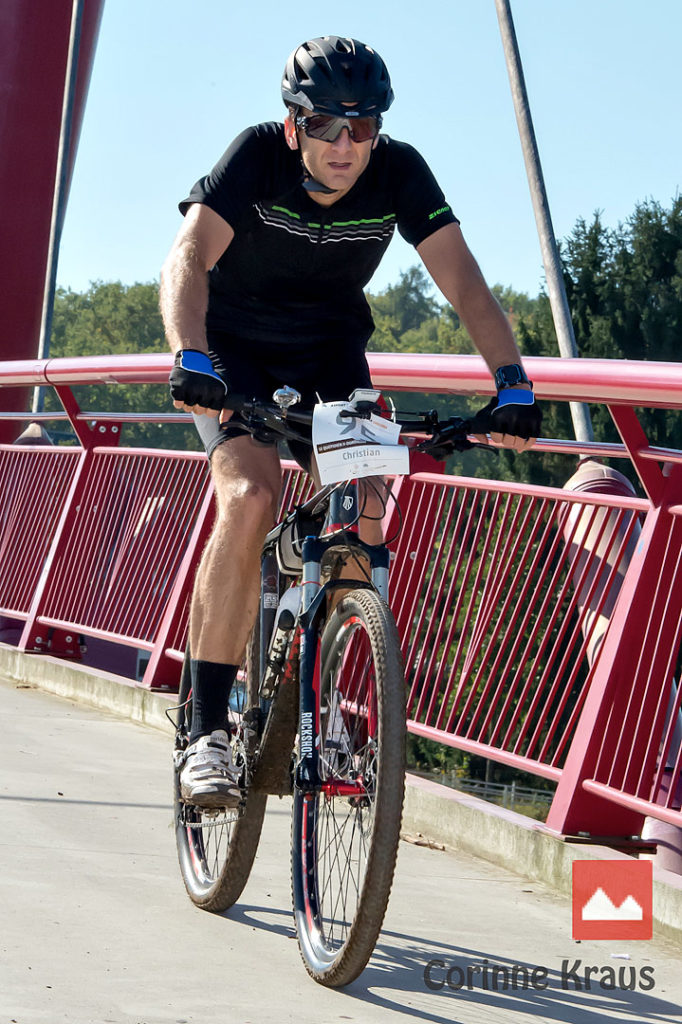
I crossed the finish line after a final bike leg of 1:08:21. I had been 38th-fastest on the bike leg again.
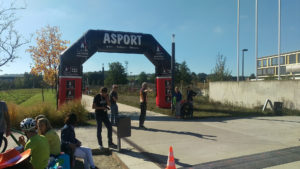
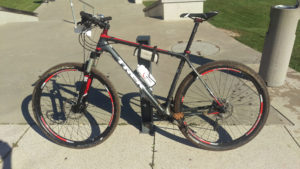
Overall ranking, and conclusion
Compared to last year’s 3:14:55, I was almost 3 minutes faster and finished in 3:12:08.
Despite coming in at 38th position on both MTB legs, due to the slow run leg I was only 42th out of 95 male finishers (44%). But that still puts me ahead of last year’s result, where I finished 40th out of 70 (57%). Putting it in percent is maybe a bit overkill in a lot of people’s minds, but for me it has been a morale boost to gradually see that percent number go down in some of my races. I’ll never be top 10%, or even 25% I think, but it’s a real challenge to see how much closer to those number I can still get in the future.
I’m fairly happy with my race execution. I did not run out of energy, and I managed to make it through the rest of the day (where I had to do two photo assignments for the newspaper) without any trouble. Last year, I had a fairly high sustained heart rate of 164 over the course of the race, and I was wrecked the rest of the day. This year, I went slightly faster but only had an average heart rate of 157; and basically felt like I could go around the course again. That’s a considerable difference, and it means that either I have become more efficient, or that I still had room to breathe and could have gone faster (or a combination of these two).
Just like last year, my bike (which is still the same Trek hard-tail) performed flawlessly. This year, I was only wearing a single layer on top, considering that temperatures were quite warm. Contrary to last year, my hydration+calorie intake was much better. I had a 0.8 litre bottle (with Isostar) on the first bike leg, a 0.6 litre bottle (with Isostar) during the run, and another bottle with 0.6 litres (with Isostar) of which I drank maybe two thirds during the second bike leg. I also had two gels during my run. That translates to around 1.8 litres of water consumed during the race (0.6 per hour), and maybe around 600-700 calories altogether.
Will I be back next year? We’ll see. It would be interesting to see if I can break the 3-hour barrier with some additional training on the mountain bike and a faster run split. There’s certainly still potential for improvement.